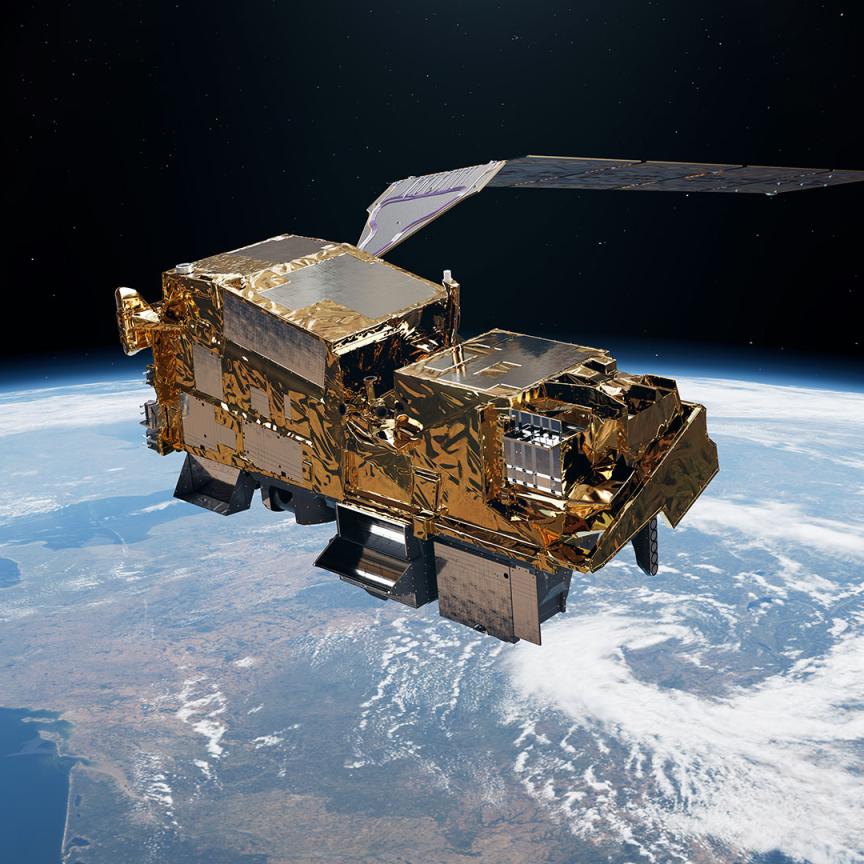Testing new aircraft design or components requires huge amounts of data – information typically gathered in a wind tunnel. The effects of turbulence, or the aerodynamics of a newly designed part, all need to undergo rigorous analysis, which might start with computer simulations but turns to actual measurement data once a prototype has been made.
The research institute Fibus, based in Hamburg, Germany, has developed vision systems for aerospace company Embraer and the German Aerospace Centre (DLR), among others, to test aeronautical components in the German-Dutch Wind Tunnels (DNW). The DNW was established by the DLR and The Netherlands Aerospace Centre (NLR), and operates a number of wind tunnels in The Netherlands and Germany.
Embraer was developing a hose for mid-air refuelling, which is a normal procedure for military aircraft, but the new design meant that Embraer wanted to test it. The challenge with refuelling mid-flight is to keep the hose very steady while the refuelling plane links up with the fighter jet. All the while, however, the hose is buffeted by vortices and turbulence from the refuelling plane. The vision system Fibus built was designed to measure the amount of motion and vibration the hose underwent as it extended.
The system used two Bonito cameras from Allied Vision operating at 4 megapixels and 400fps. Teledyne Dalsa’s Xcelera PX8 frame grabbers transferred data to a PC.
Since the Bonito camera has a double Full Camera Link interface, two frame grabbers were needed for each camera. Dr Reinert Müller, the director of the Fibus institute, noted that the two cameras necessary for stereo 3D reconstruction of hose vibration, the four frame grabbers and Camera Link extenders, made it quite a complicated system.
At an 85MHz pixel clock, the maximum cable length for the system was around five to six metres, explained Müller. ‘The wind tunnel is big, eight metres in diameter, and the centre of the tunnel is around 12 metres high,’ he said. The system used Camera Link extenders from Imperx to get eight to nine metres.
The cameras tracked marker paint on the airplane hold, which converts UV LED illumination to yellow light. Using filters, Embraer could do particle image velocimetry (PIV) measurements at the same time as the hose tracking measurements, explained Müller, because PIV is in the green portion of the spectrum.
When the system was first set up, a lack of lighting meant the camera frequency had to be reduced to 200fps to get longer exposure time, but later measurements had more light – enough to use 400fps. ‘Two hundred frames per second gave us some problems tracking at very high vibrations,’ Müller said. ‘It depended on aircraft angle of attack and wing and engine configuration. If everything was relatively stable, 200fps was good enough. Only in a few cases in certain angles of attack of the plane, we got so much turbulence that the hose was vibrating heavily.’
All the necessary data was successfully acquired, although some of the images shot at 200fps needed extra post-processing. Fibus’ software, PicColor, which is standard software for wind tunnel measurements, was used for the image analysis.
According to Müller, the complexity of the system meant that high speed interfaces like CoaXPress or Camera Link HS would have been preferable to the Camera Link interface used in this particular project. Fibus has since designed high-speed systems using Mikrotron’s EoSens 4CXP camera, which runs at more than 500fps. The system used a CoaXPress interface with a Silicon Software frame grabber.
‘The hose project worked well,’ reported Müller. ‘The customer was happy with the system. The Teledyne Dalsa Sapera driver for the frame grabbers is excellent, especially its control functionality. Everything is very symmetric. A big advantage was the ability to acquire images from two frame grabbers on one buffer in the computer; there are not many frame grabbers that do that.’ This functionality of each frame grabber contributing half an image to the parent buffer is called Multi-Board Sync and is unique to Teledyne Dalsa.
Whirling rotors
Müller commented that future projects are likely to need more than two cameras, which makes the system more complex. Using multiple frame grabbers, for instance, is difficult because there are few motherboards on the market with more than five fast PCI Express slots, Müller said.
Fibus developed its first project with four cameras last September for the German Aerospace Centre (DLR) for testing a new helicopter swashplate configuration, a device that controls the motion of the blades. The project, called FTK-META, was run at the DNW Large Low-speed facility in The Netherlands.
Helicopters are not very efficient and noisy because of blade-vortex interactions, explained Müller. Every aircraft wing or helicopter rotor blade produces a strong vortex at the tip. An aircraft flies away from the vortex but, with a helicopter, the rotor blades are turning through the vortices, which generates a highly unsteady dynamic load. There are also supersonic effects on the forward moving blades in fast forward flight.
One way to reduce blade-vortex interactions, noted Müller, is to use special tip shapes, such as BERP tips that are wider at the end, or double sweep blades, such as the ERATO – developed by DLR and French aerospace lab Onera – that recently became operational on the new H160 Airbus helicopter. Another possibility is to change the angle of attack of the blades, which is what the DLR project was aiming to achieve with the new swashplate design. ‘They are trying to use a special form of higher harmonic control,’ explained Müller, ‘with optimised angle of attack for the advancing and retreating blade at azimuthal positions where the vortex interaction is very strong. It’s a complicated control of the blade angle of attack to alleviate the effect of vortices.’
The project compared a rotor with conventional rectangular blades with the developmental blade design. ‘It was complicated, because we had so many flight configurations and they wanted to have high resolution and high accuracy,’ remarked Müller. The system had an accuracy of 0.2mm when imaging the four-metre diameter rotor blade. The entire radial distribution of angle of attack was recorded at every position of the four blades and for every operational condition.
Ultraviolet markers on the leading and trailing edge of the rotor blades were tracked with four high sensitivity PCO.2000 cameras at four megapixel resolution, although, unlike the Embraer project, high frame rates were not required here. The rotor was triggered to give images taken at a certain azimuth positions. The result was 3D rotor blade position data of the two different rotors at many different flight configurations. The data was then correlated with other measurements of drag, lift, noise, vibration and rotor power.
‘We did some initial real-time processing to see if the data was usable. We then did a lot of post-processing to track all the markers – around 200 of them – find and match them in the images automatically using Epipolar geometry, and reconstruct 3D motion,’ said Müller.
Müller added that camera sensors are getting faster and higher resolution, which poses a problem for interface connectivity and frame grabber hardware. ‘In one or two years we will have 10GB/s transfer and there’s no frame grabber that can do that,’ Müller commented.
‘SFP+ or Quad-SFP+ modules are widely used in data server applications and have 10Gb/s or respectively 40Gb/s transfer speed over glass fibre and very long distances,’ he continued. He said the hardware is there, but frame grabber manufacturers need to design the software. Fibre optic connections are also important for Fibus and wind tunnel measurements, because of the size of the facilities.
Servicing planes in 3D
Outside of wind tunnel testing, machine vision is used in both aerospace component manufacture and for inspecting planes during service and repair. Technicians servicing aircraft, for instance, typically use handheld laser scanners to give image data on any faults they find on the shell of the plane. Machine vision company, Matrox Imaging, has supplied image processing solutions for equipment providers that make these scanner systems for aircraft manufacturers like Boeing and Airbus.
Sam Lopez, director of sales and marketing at Matrox Imaging, noted that ‘one of the big challenges in the aerospace industry is that you’re dealing with very large objects’.
‘There’s no single system for scanning an entire aircraft,’ he said, ‘so even today trained technicians will look at the aircraft visually, and then every time they find something that requires closer attention, they will use these scanners to document the imperfection. Our MIL software makes these scanners a lot easier to use and get readings from.’
The scanners are used to get accurate data on the diameter and depth of any dents in the wing or surface of the plane. The technicians are trained, noted Lopez, and know how quickly to scan, and the distance from the surface the instrument needs to be to get a readable image. Usually an area of around one square metre is inspected.
While an experienced technician can acquire a reasonably accurate image, any variation in the way the instrument is used is compensated for by the software. ‘As part of the Matrox Imaging Library (MIL), we’ve put in algorithms that compensate for a certain amount of irregularities in distance of the scanning instrument from the surface of the aircraft, and still get an accurate reading,’ explained Lopez. ‘It still has to be within a certain tolerance range, but there is a degree of flexibility.’ Basically, the smaller the defect, the closer the scanner has to be to the surface, or the higher the resolution of the camera.
Matrox Imaging has been involved in inspection projects for a number of large aerospace companies, and Lopez noted that 3D imaging is playing a big role in applications like engine part inspection. ‘You’re dealing with fairly complex, typically metal machined parts,’ he said. ‘These are smaller components that do lend themselves well to inspection machines that can scan those parts in their entirety. Here, it’s either laser scanning devices or fringe pattern projection techniques.’
These systems are typically stand-alone systems, inspecting the part off-line. Analysis is automated or carried out by an operator. Matrox Imaging has been involved in a recently deployed project for designing a system to inspect the turbine blades on jet engines. ‘A turbine blade is shaped in a specific way, with a lot of curvature and changes in thickness from the leading edge of the blade to the trailing edge,’ commented Lopez. ‘So 3D becomes extremely important here. With 2D imaging it would be virtually impossible to inspect the full surface area of a blade accurately.’
The other technology that’s now being used more often in aerospace manufacture is endoscopy, according to Lopez. Endoscopes allow technicians to look inside a component or engine, and view the inner surface of a part that would otherwise be difficult to image.
‘We’re getting to the point where just about every small component is inspected 100 per cent before it gets assembled,’ he commented. ‘Even a lot of the subassemblies, once they are built, get scanned and are inspected to make sure they are assembled correctly, as well as to ensure that part tolerances are met so that components will fit together during production.’
The testing and manufacture of aerospace parts rely heavily on imaging techniques, and the DNW wind tunnels are running numerous projects experimenting on new designs, and on how the environment affects aircraft. One such project, called STORM, conducted by the German Aerospace Centre, is investigating the potential damage ice debris could cause to engines and downstream aerodynamic surfaces. Two high-speed cameras and dedicated post-processing image analysis were used to track the trajectories of generic ice particles in the study. This and other work requires specialised and complex imaging setups to generate accurate data.


